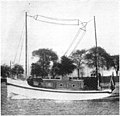File:Wireless antenna on boat 1914.jpg
From Wikimedia Commons, the free media repository
Jump to navigation
Jump to search

Size of this preview: 618 × 600 pixels. Other resolutions: 247 × 240 pixels | 495 × 480 pixels | 792 × 768 pixels | 1,056 × 1,024 pixels | 1,472 × 1,428 pixels.
Original file (1,472 × 1,428 pixels, file size: 260 KB, MIME type: image/jpeg)
File information
Structured data
Captions
Captions
Add a one-line explanation of what this file represents
canot de sauvetage à moteur appartenant à la ligne Cunard montrant l'antenne de télégraphie sans fil.
Summary[edit]
| DescriptionWireless antenna on boat 1914.jpg |
English: A motor lifeboat belonging to the Cunard Line showing the wireless telegraphy antenna. One of the first uses of radio was on ships, to call for rescue if they were sinking, and after the high profile 1912 Titanic sinking the US and UK governments required wireless equipment on all large vessels. This was a rescue launch assigned to the RSS Aquitania designed to tow lifeboats to safety, and was equipped with a Marconi wireless set to communicate with the ship. The primitive radio of the time used spark gap transmitters which couldn't transmit sound but instead communicated by wireless telegraphy, the operator turned the transmitter on and off rapidly with a telegraph key to spell out text messages in Morse code. Ship wireless used wavelengths of 600 and 300 meters (500 kHz and 1 MHz). This was called an "inverted-L" antenna, common on ships, consisting of a vertical feedline from the transmitter attached to a horizontal line. between two masts. The vertical feedline radiated the radio waves, while the horizontal part acted as a capacitive "top-load" to increase current in the antenna. Each conductor is composed of four wires separated by wooden spreaders, to increase the capacitance and decrease the resistance of the antenna, increasing the radiated power. The transmitter was equipped with a hand-cranked generator, in case the ship's generator broke down. Alterations to image: Removed aliasing artifacts (crosshatched lines) introduced by scanning of the halftone photo using Gimp FFT filter. Français : Un canot de sauvetage à moteur appartenant à la ligne Cunard montrant l'antenne de télégraphie sans fil. L'une des premières utilisations de la radio a été sur les navires, pour appeler au sauvetage en cas de naufrage, et après le naufrage du Titanic de 1912, les gouvernements américain et britannique ont exigé des équipements sans fil sur tous les grands navires. Il s'agissait d'un lancement de sauvetage affecté au RSS Aquitania conçu pour remorquer des canots de sauvetage en toute sécurité, et était équipé d'un ensemble sans fil Marconi pour communiquer avec le navire. La radio primitive de l'époque utilisait des émetteurs à éclateur qui ne pouvaient pas transmettre de son mais qui étaient plutôt communiqués par télégraphie sans fil, l'opérateur allumait et éteignait rapidement l'émetteur avec une clé télégraphique pour épeler les messages texte en code Morse. Navire sans fil utilisé des longueurs d'onde de 600 et 300 mètres (500 kHz et 1 MHz). Cela s'appelait une antenne "en L inversé", courante sur les navires, consistant en une ligne d'alimentation verticale reliant l'émetteur à une ligne horizontale. entre deux mâts. La ligne d'alimentation verticale rayonnait les ondes radio, tandis que la partie horizontale agissait comme une "charge supérieure" capacitive pour augmenter le courant dans l'antenne. Chaque conducteur est composé de quatre fils séparés par des épandeurs en bois, pour augmenter la capacité et diminuer la résistance de l'antenne, augmentant la puissance rayonnée. L'émetteur était équipé d'un générateur à manivelle, au cas où le générateur du navire tomberait en panne.
. |
| Date | |
| Source | Retrieved October 22, 2013 from "Wireless Equipment of Motor Lifeboats" in The Wireless Age magazine, Marconi Publishing Corp., New York, Vol. 1, July, 1914, p. 853 on Google Books |
| Author | Unknown authorUnknown author |
Licensing[edit]
| Public domainPublic domainfalsefalse |
This media file is in the public domain in the United States. This applies to U.S. works where the copyright has expired, often because its first publication occurred prior to January 1, 1929, and if not then due to lack of notice or renewal. See this page for further explanation.
|
||
This image might not be in the public domain outside of the United States; this especially applies in the countries and areas that do not apply the rule of the shorter term for US works, such as Canada, Mainland China (not Hong Kong or Macao), Germany, Mexico, and Switzerland. The creator and year of publication are essential information and must be provided. See Wikipedia:Public domain and Wikipedia:Copyrights for more details.
|
File history
Click on a date/time to view the file as it appeared at that time.
| Date/Time | Thumbnail | Dimensions | User | Comment | |
|---|---|---|---|---|---|
| current | 15:07, 30 September 2020 |  | 1,472 × 1,428 (260 KB) | Hohum (talk | contribs) | Upload colourised images separately |
| 18:09, 4 April 2020 |  | 1,280 × 1,242 (185 KB) | F1jmm (talk | contribs) | colorisation | |
| 08:53, 15 March 2014 |  | 1,472 × 1,428 (260 KB) | Chetvorno (talk | contribs) | User created page with UploadWizard |
You cannot overwrite this file.
File usage on Commons
There are no pages that use this file.
File usage on other wikis
The following other wikis use this file:
- Usage on fr.wikipedia.org
Metadata
This file contains additional information such as Exif metadata which may have been added by the digital camera, scanner, or software program used to create or digitize it. If the file has been modified from its original state, some details such as the timestamp may not fully reflect those of the original file. The timestamp is only as accurate as the clock in the camera, and it may be completely wrong.
| JPEG file comment | Created with GIMP |
|---|


